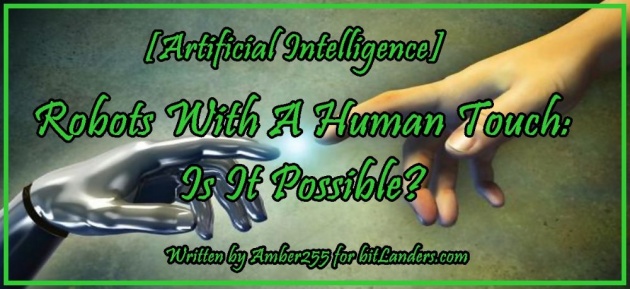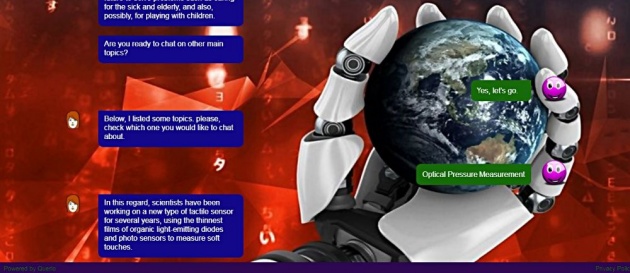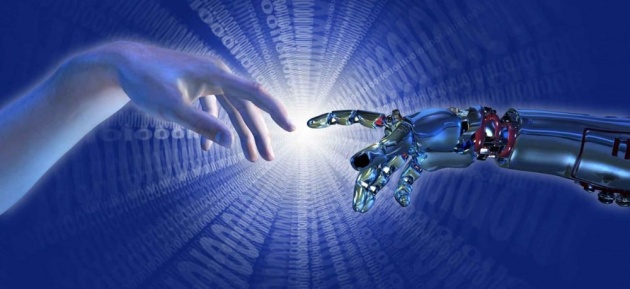
[Artificial Intelligence] Robots With A Human Touch: Is It Possible? - Photo credit: blog, edition by Amber255 via bitLanders
Did scientists think that someday it will be possible to imitate human feelings? For example, touch. Meanwhile, American experts have created a sensor that can feel the texture of objects like human fingers.
Human hands can distinguish objects as small as 40 microns, half the thickness of a hair. The sensor created now distinguishes objects within a millimeter, but scientists believe that this development can become the basis for creating robotic hands that, in touch, will not concede to human ones.
The brain is at one end; the hand is at the other. It’s the interface that’s the challenge.
Credit: pursuit
Smart Artificial Skin
The group of specialists who developed the sensor believes that in the future this sensor with a delicate sense of touch will help to develop minimally aggressive surgical methods, allowing surgeons to feel any touch themselves, thus providing a breakthrough in medicine.
One can hope that a device that feels the same way as a human finger will find its application in minimally aggressive surgery when the surgeon can touch this or that tissue of the patient and establish whether it is malignant or not. Undoubtedly, this should greatly increase the opportunities and successes of surgery.
Robots with a human touch - Video credit: youtube
Professor Ravvi Saraf and his team were able to achieve this level of machine sensitivity through the use of a very thin film made of several layers of metal and semiconductor nanoparticles.
When the film touches the surface of the object, the slightest pressure compresses its layers: this causes a change in current in the texture of the device, after which the charged particles emit light. This phenomenon is called the effect of electroluminescence. Visible light is then processed by the camera.
According to Professor Saraf, one of the unique characteristics of the new sensor is that the level of current change in the film, or light, is proportional to the applied force.
This material is extremely flexible. This feature will allow it to be placed on complex surfaces. Another important advantage is that the sensor can distinguish between the hardness of objects. It will help to more easily identify, for example, gallstones and cancers.
The technology created is cheap enough: producing a square inch of the material will cost only 50 cents.
Earlier in Japan, it was announced that artificial skin was being developed at the University of Tokyo. It was reported that it already feels pressure and temperature. Scientists have announced their intention to add to the smart artificial skin a sensation of light, moisture, stretching or sound. At the same time, Japanese experts did not exclude that all this is possible very shortly. Besides, they were not going to dwell on a simple imitation of the original - scientists intend to endow the robotic skin with functions and properties that human skin does not possess.

[Artificial Intelligence] Robots With A Human Touch: Is It Possible? - Photo credit: querlo
Visual And Touch Sense Combination
Scientists have reported the creation of a system that provides a connection and interaction of various senses. For starters, researchers tied the vision and touch.
The CSAIL pilot installation was made based on predictive artificial intelligence (AI) technology, which is programmed to teach computer vision through the tactile sensations of sensors. And vice versa: AI will be able to teach the machine sense of touch to recognize the properties of objects from visual data.
For a person, a complex mutual complement of sensory organs is a natural habitual practice. We do not have to touch most of the usual things to determine their properties. In most cases, just a look is enough to determine that the glass is full, the brick is rough, and the stairs lead up, not down. And vice versa: to determine the size of a hole in a pocket, it is not necessary to see it at all - just feel for it with your fingers. You can move in complete darkness with cautious steps with outstretched arms.
For machines, this combination of senses is very important. For example, a production robot that tries to switch a knife switch outside its field of vision: it knows for sure where the knife switch is located, but without cognitive touch, it can easily grab a human colleague’s hand and commit unintentional self-harm.
Smart vision, in turn, will also be able to tell the robot that, for example, the ball in front of it is not necessary to drag it - it will be easy enough to roll it. There are thousands of such examples from life.
Check my new Querlo chat and find more info on these topics:
1. Smart Electronic Skin 2. Optical Pressure Measurement
3. Touch Pressure Measurement:
a) Daily touch and force measurement b) Soft and flexible sense of strength
4. Liquid metal for robots sense of touch 5. Touching Sensors for Robots
Please, chat with me on Robots With A Human Touch: Is It Possible? (link opens chat in a full-screen mode):
In the future, such interpenetration of computer feelings may contribute to the successful and seamless integration of a person with a robot in industrial or even domestic conditions.
How does it work? In their study, scientists combined a self-learning predictive AI with an industrial-grade manipulator. The robotic arm was equipped with a tactile 3D sensor. For teaching AI, an ordinary webcam was used, with the help of which 12 thousand videos were shot with about two hundred different everyday objects - such as tools, household items, fabrics and more.
To train AI, researchers used a set of images and a machine learning algorithm. The essence of the algorithm is the simultaneous use of two neural networks, one of which acts as a teacher by launching a flow of control images, and the second learns to distinguish original images from generated ones.
In the case of the development of researchers from CSAIL, generative-competitive networks were used to teach AI visual skills through tactile properties, and touch skills through images. Two neural networks work with each other based on competition, as a generator and discriminator.
Combining the two senses can expand the capabilities of the robot and reduce the amount of data that is needed for the manipulators to work and capture objects.
On A Final Note
Robots can see, hear and learn to touch. Scientists managed to create a predictive artificial intelligence, with the help of which the robot improves its vision through tactile sensations, and vice versa. Integration and mutual complementation of feelings is a familiar function for humans, but for robots this is new. The prospects for commercializing new technology are very good.

[Artificial Intelligence] Robots With A Human Touch: Is It Possible? - Photo credit: inc
The combination of visual and tactile perception opens up broad prospects in terms of the commercialization of such developments. First of all, such technologies are in demand in the industry of social robots - cybernetic medics, carers, business assistants and in all other areas, implying close contact of artificial intelligence with humans.
In recent years, the development of the so-called artificial skin for robots, capable of not only imitating human skin but also fully conveying the whole range of tactile sensations, has attracted considerable interest.
************************************************************************
****************************************************************
****************************************
I invite you to participate in Bitlanders AI-themed Blogging and create your own AI-themed blogs and C-blogs on artificial intelligence theme:
bitLanders AI-themed blogging
After the successful launch of "The bitLanders C-blogging", conversational AI blogging by Querlo powered by IBM Watson and Microsoft Azure. bitLanders continues to support its joint venture Querlo. We believe in our mission to promote our future - Artificial Intelligence (AI) - and build AI conversations via blogging, here we are to introduce "bitLanders AI-themed blogging!"Credit: quote from bitLanders
Always welcome back to check more Querlo Chat blogs on Artificial Intelligence theme.
***************************************************************************************************
Thank you for stopping by and reading my blog.
2019, All Rights Reserved.
You are very welcome to join Bitlanders and share your valuable knowledge and opinion.
***************************************************************************************************



